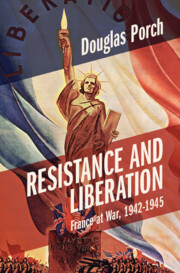Book contents
- Resistance and Liberation
- Armies of the Second World War
- Resistance and Liberation
- Copyright page
- Contents
- Figures
- Maps
- Preface
- Abbreviations
- 1 Tunisia
- 2 “A Sort of Resurrection of France”
- 3 Triumph and Dishonor in Italy
- 4 Resistance on the Eve of D-Day
- 5 “The Supreme Battle”
- 6 Anvil/Dragoon
- 7 L’amalgame
- 8 Les Vosges
- 9 Rhine and Danube
- 10 Conclusion
- Notes
- Bibliography
- Index
2 - “A Sort of Resurrection of France”
Published online by Cambridge University Press: 05 January 2024
- Resistance and Liberation
- Armies of the Second World War
- Resistance and Liberation
- Copyright page
- Contents
- Figures
- Maps
- Preface
- Abbreviations
- 1 Tunisia
- 2 “A Sort of Resurrection of France”
- 3 Triumph and Dishonor in Italy
- 4 Resistance on the Eve of D-Day
- 5 “The Supreme Battle”
- 6 Anvil/Dragoon
- 7 L’amalgame
- 8 Les Vosges
- 9 Rhine and Danube
- 10 Conclusion
- Notes
- Bibliography
- Index
Summary
The Tunis victory parade, followed by the “fusion” of the Free French and l’armée d’Afrique, symbolized a transition between the old and new French army, rearmed as the result of the Anfa conference, so that French troops might take part in the liberation of their country. For France to assume its “place among the democratic nations of the world,” the French exile movements of de Gaulle and Giraud needed to cooperate, while a third resistance army was mobilizing within the hexagon. How to coordinate, “fuse,” and “amalgamate” these three forces would preoccupy French and Allied leaders for the remainder of the war. Resurrecting French military power in an impoverished and fractious French North Africa would prove problematic. De Gaulle’s 30 May 1943 appearance in Algiers launched his struggle with Giraud for control of the CFLN. The two factions competed to recruit the trickle of évadés de France to Casablanca via Spain, as well as women to fill non-combatant roles, a rivalry, tinged with rancor, that would linger until the war’s end, and become even more complex when the internal resistance was added to the mix. These minor “crises” highlighted just how diminutive French forces actually were in the larger context of the war. They also signaled that French and Allied goals would diverge, as the French leader prioritized the preservation of empire; the restoration of order and the State upon liberation; and securing France’s post-war interests in Germany.
Keywords
- Type
- Chapter
- Information
- Resistance and LiberationFrance at War, 1942-1945, pp. 83 - 160Publisher: Cambridge University PressPrint publication year: 2024

